Abstract
The green economy is a form of economic progress. It promotes environmentally sustainable, low-carbon, and inclusive development. It ensures environmental sustainability and preserves the conditions for social progress. The current model of resource management is not sustainable and puts pressure on the environment. The proposed steps toward a green economy are intended to benefit both the environment, the economy, and society. The aim of the study was to assess the spatial differentiation of the relationship between the green economy and the zero waste concept of Eastern Poland’s municipalities. The assessment was performed using a synthetic measure. The choice of variables was determined by the availability of data in the Bank of Local Data of the Central Statistical Office (BDL GUS) for the years 2010–2020 in spatial terms (709) municipalities of Eastern Poland. The synthetic measure of green economy ranged from 0.28 to 0.56 in 2010 and from 0.28 to 0.59 in 2020; and for the waste management measure, from 0.19 to 0.55 in 2010 and 0.32 to 0.53 in 2020. Spatially, the essence of the green economy or zero waste stems from the desire to reduce the burden on the environment by creating attractive conditions for living and business activities. The development of the green economy is to shape the aspect of the environment, while ensuring economic security and quality of life.
1. Introduction
The multitude of factors (location rent, location attractiveness of areas with developed infrastructure, historical conditions, social, environmental, and economic aspects) influencing the pace and direction of changes taking place in the local economy results in a significant diversification of the socio-economic development of spatial units [1]. A new approach to consider the path of socio-economic development is green economy. Defined as a low-emission economy, efficiently using resources and socially integrated, it is the basis for the implementation of sustainable development. It is seen as a way to economic development while preventing environmental degradation, biodiversity loss, and unsustainable use of natural resources. The natural environment is a source of resources necessary for the economy and society, a source of endogenous capital.
The natural environment in the green economy plays a production function (constituting the base of raw materials for the economy and society), supporting the absorption of pollutants and waste storage, living space for people (determinants of the quality of their life), as well as a place for enterprises to operate. It plays an important determinant of changes in the transformation of the economy towards sustainable green development in the green economy [2].
The green economy (GE) is a form of economic progress. It promotes environmentally sustainable, low-carbon and inclusive development. The sustainable development by ensuring environmental sustainability and maintaining the conditions for social progress [3]. Green economy is to ensure the supply of renewable resources for the development of the economy, while ensuring the minimization of the environmental impact associated with obtaining, using, and processing natural capital. It aims to solve ecological problems related to increasing pollution, the generation of excessive amounts of waste, and unsustainable use of resources. Green economy is a system of economic activities related to the production, distribution, and consumption of goods. It does not expose future communities to environmental risks and shortages [4]. The implementation of green economy is conditioned by technological development, generating eco-innovations, promoting the sustainable use of resources, and limiting the degradation of the natural environment [5].
Efficient waste management is a key element in the transition to a circular economy. It requires careful consideration of, inter alia, the scarcity and security of supply of specific resources, costs, energy efficiency, and environmental impact. When dealing with environmental problems, we need to adapt measures to local conditions by analyzing the relationship between resources, the environment and development [6]. The current resource management model is unsustainable and puts pressure on the environment. The proposed actions towards a circular green economy are intended to benefit both the environment, the economy, and society by maximizing the use of all raw materials, products and waste. It is associated with a dynamic increase in consumption and the generation of increasing amounts of industrial and municipal waste. The zero waste concept (within the circular economy) is an approach that reorganizes the entire life cycle of resources so that all products can be reused. The general idea is that all consumed materials can be used by other entities as resources, rather than creating waste [7]. The sharing economy is indicated as an element that can be equated with the response to human needs, related to the increase in the quality of their lives and more efficient use of resources [8].
Socio-economic development is defined as a process of positive changes in quantitative growth and qualitative changes. It refers to the local dimension of a given territorial unit and to the local community, its needs, preferences, and priorities as well as recognized value systems, or the quality and quantity of endogenous territorial capital [9]. Development is a harmonized and systematic activity aimed at creating favorable conditions for the local economy, including ensuring spatial and ecological order [10]. Sustainable development means promoting economic development while ensuring that natural assets continue to provide resources and environmental services [11]. It is focused on the needs of the local community, environmental protection, and the ability of the environment to meet current and future social needs [12].
The endogenous potential of municipalities, i.e., the natural, economic, and social environment and infrastructure, allows freedom of economic activity. Such activity is used in different in relations in the local economy, i.e., economic and social, interdependently, and occur simultaneously.
The aim of the research was to evaluate the spatial differentiation of the relationship between the green economy and zero waste (ZW) (waste management) concept in Eastern Poland municipalities using a synthetic measure. It enables grouping of the researched units from the point of view of the main criterion. It also allows you to indicate to what extent the variables of its structure determine it. The study discusses the premises of the concepts of green economy and zero waste. Their mutual relations were indicated, and key areas are characterized from the point of view of the commune’s economy. The authors, supplementing the main goal, decided to formulate research questions: What is the spatial differentiation of the green economy and zero waste in terms of communes in Eastern Poland? How is their level mutually determined by diagnostic variables?
2. Literature Review
Changes in the relationship between economic, environmental, social, and political elements taking place in the world economy require a new approach to the process of socio-economic development. One of the paths to sustainable development is GE. It has the advantage of making sustainable development more concrete and operationalized [13]. The problems affecting the local economy (i.e., environmental, social, and economic) are interrelated and complicated. They are becoming one of a serious challenge for governments, politicians, and decision makers [14]. Greening the economy is considered in many dimensions, e.g., development of clean technologies, renewable energy sources, improvement of energy efficiency, changing the consumption and production model to a more sustainable one (greening industry, transport). The necessity in terms of changes in the situation of regions (as a result of the economic crisis, energy crisis, high price spike) or appropriate management of natural resources is becoming a process of transformation towards a green economy. It is also necessary to point out the need to increase resource efficiency, promote sustainable consumption and production, combat climate change, and reduce pollution as challenges that concern regional policy [15]. It does not replace the concepts of balanced and sustainable development regarding living conditions and improving local and regional competitiveness [16].
Green economy is one of the important tools for ensuring sustainable development. It is an economy characterized by a high standard of living, prudent and rational use of natural resources [17]. It includes an ecological aspect (reduction of CO2 emissions, resource efficiency) and a social aspect (counteracting social exclusion) [4,18]. A green economy is a sustainable economy that uses energy produced entirely from renewable sources (Figure 1) [19]. It can be analyzed in terms of sectors (includes the sectors of renewable energy sources, ecological building materials, ecological transport, water and waste management) and spatially (space management) [20].
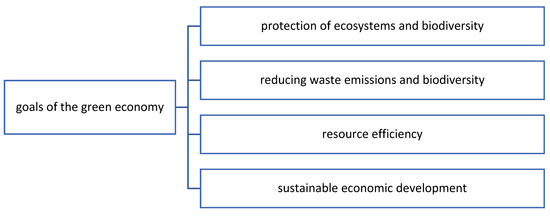
Figure 1.
Goals of the green economy. Source: study based on Iwona Bąk, Katarzyna Cheba, Zielona gospodarka jako narzędzie zrównoważonego rozwoju, wyd. CEDEWU 2020; Marcin Rabe, Zielona gospodarka jako narzędzie zrównoważonego rozwoju, Studia i Prace Wydziału Nauk Ekonomicznych i Zarządzania 46/2, 117–124, 2016.
The green economy increases people’s well-being and social equality, while reducing environmental risk and the consumption of natural resources. It includes an ecological aspect and a social aspect [4]. Deterioration of the natural environment affects the quality of life of the population [21]. The green economy promotes a balance between environmental, social, economic factors. It strengthens the process of sustainable development, environmental protection, and quality of life.
In spatial terms, interest in green economy results from efforts to reduce the environmental burden on regional systems, and to improve regional and local competitiveness. It is a low-carbon, resource-efficient and socially inclusive economy. The green economy system includes sustainable production, consumption, and distribution dimensions: social, economic, and ecological [22]. Green economy is a path of economic development that will be possible in a sustainable manner, taking into account environmental constraints related to the availability of resources and environmental services (Figure 2) [23].

Figure 2.
Dimensions of the green economy. Source: study based on B. Ryszkowska, Green economy—theoretical foundations of the concept and measurement of its implementation in the European Union, Ed. UE in Wrocław, Wrocław 2013.
There are specific relationships between the elements of the green economy. They lead to the identification of areas enabling the monitoring of the condition of the green economy, i.e., natural capital, environmental production efficiency, environmental quality of life of the population, economic policies, and their consequences [24]. Green economy contributes to the reduction of environmental pollution and better use of scarce resources (including natural resources), as well as influencing the region’s green growth (improving the region’s green capital) [25,26]. The sustainable and environmentally friendly way of waste disposal, the idea of recycling and reuse, is crucial to protect the environment and human health [27]. However, measuring the efficiency of the green economy at the regional level is associated with additional limitations compared to the indicators at the national level (the authors propose their own set of diagnostic variables allowing for the assessment of the studied area) [28].
The essence of the green economy is the creation of solutions enabling better adaptation of the economy to the specificity of the environment [29,30]. The environment is the main source of resources that make life easier and foster development. Green economy means an economy focused on solving environmental problems, i.e., increasing pollution, generating excessive amounts of waste, and unsustainable use of resources [17]. The transition from a traditional economy to a green economy will certainly affect all sectors of the economy (industry, trade, agriculture, tourism). The green economy promotes the concept of the triple bottom line (profit, society, planet) [31]. It is beneficial for the region’s economy in the social, environmental, and economic area, ensuring better ways of using resources or eliminating environmental pollution and the region’s ecological growth [32].
While traditional economic models suggest that unequal patterns of production and consumption are the desired outcomes of welfare, economic systems are related to the environment [33]. Circular economy, in order to ensure sustainable development, rely mainly on the so-called the 3R principles, i.e., reduction, reuse, recycling [34,35]. From the economic point of view, it is in contrast to the linear economy, presented as: obtaining raw materials, processing them, and then disposing of the product. The circular economy also has a territorial dimension. In the context of the functioning of regions, it refers to, for example, the concept of the sharing economy, according to which unlimited consumption or accumulation of property give way to their joint use, exchange or lending of goods [36].
A circular economy is the pursuit of a waste-free economy. Zero waste (ZW) is an approach that reorganizes the entire life cycle of resources so that products can be reused. The circular economy model is characterized by a closed structure, presenting a new approach to the flow of resources, as opposed to the linear economy model [37]. Economic development contributed to the increase in waste production. Sustainable municipal waste management requires comprehensive treatment, taking into account economic, environmental, and social conditions. We should therefore start treating waste as a raw material. Waste can be reused, recycled or, as a last resort, recovered for energy purposes.
The source of waste in the region are consumption and production processes. Waste is the result of inefficiency in society and evidence of a waste of resources. The increase in the amount of waste affects the authorities to manage waste in a more sustainable way (i.e., to reduce its quantity, to handle it in an environmentally and socially friendly way). ZW is a response to the dynamic increase in consumption and waste, supporting the use of raw materials and creating incentives to stop waste, avoid waste generation and protect raw materials. ZW comes down to the application of certain rules, the so-called 5R: refuse, reduce, reuse, recycle, compost (rot) [38]. The state of waste management and the level of environmental pollution are presented as a complex phenomenon, and therefore described by several variables [39]. ZW is a holistic concept of waste management that recognizes waste as a resource that results from the use of resources [40]. The benefits of introducing the ZW concept include the community, financial and economic, environmental, and industry and stakeholder aspects in both macro- and microenvironments [41]. The ZW rules communicate that the emphasis should be on resource efficiency and avoiding waste.
The hierarchy of handling raw materials according to the ZW concept means avoiding waste generation and the recycling process [42]. Improper waste management has a negative impact on human health, the environment, economy, and society [43,44,45].
Waste management should be subordinated to an environmental protection framework of reduction and recycling, which has its own limitations [46]. Waste has become one of the major environmental problems. There is an urgent need for a sustainable strategic waste management system to prevent further depletion of these natural resources [47]. The scarcity of resources and the growing amount of waste generated forces their reduction [48]. The recovery and reuse of materials from waste is ultimately becoming an important economic issue. Waste management means waste generation and waste management [49].
Waste management is understood as collection, transport, processing, including supervision over such activities, as well as, inter alia, subsequent handling of waste disposal sites [50]. Waste management is a complex, interdisciplinary concept, covering both planning and implementation of projects and technologies and their control [51]. Waste management can be considered in terms of process and subject matter. In waste management processes, waste prevention is preferred, and landfilling is the least desirable. In the subject system, there are types of waste (municipal, household, economic) [52,53].
3. Materials and Methods
When undertaking research on the spatial differentiation of municipalities in terms of the concept, i.e., zero west and green economy, a certain number of diagnostic variables should be distinguished [54]. The spatial (intra-regional) polarization of the variables of the studied areas in the contemporary economy occurs primarily between cities (regions of growth in the region) and peripheral areas, urban and rural communes [55]. This differentiation seems to be a natural process. However, given the lack of boundaries in the displacement of pollutants, the strong impact of individual environmental areas on others surrounding them is a sufficient reason to conduct research on the spatial differentiation of selected areas in terms of selected criteria. For this purpose, the authors used the method of multidimensional comparative analysis, for which statistical data were collected in the spatial terms of communes of Eastern Poland. The choice of variables was conditioned by the availability of data in the Local Data Bank of the Central Statistical Office (BDL GUS) for the years 2010–2020. The research was carried out dynamically (taking into account the minimum and maximum values for the entire research period).
The main goal of a multivariate comparative analysis is the construction of a synthetic measure that enables the comparison of units (e.g., poviats) described by means of many diagnostic variables. The process of its construction is a series of successive stages.
Selection of research objects, selection of diagnostic variables and their verification in terms of statistics and content. The division of variables into stimulants and destimulants: stage 1.
Difficulties related to the implementation of the study were due to, among other things, the availability of diagnostic variables related to the main criterion of the analysis (green economy, waste management, changes in legal regulations in the area of finance or tasks of territorial units, changes in the administrative division, changes in the socio-economic situation, and random events. In the article, the authors focused on selected variables described in Table 1.

Table 1.
Diagnostic variables describing zero west and green economy at the level of communes.
The selected diagnostic variables are characterized by sufficient discriminant ability. Diagnostic variables characterized by low variability (border value of the variation coefficient = 0.10) were selected for the study. Over-correlated variables (diagonal elements correspond to them) were removed from the study in the case of the inverse matrix, with values greater than 10 are eliminated from the set of variables [56,57]. Variables strongly correlated with each other as carriers of similar information were also eliminated (threshold level of the correlation coefficient value r* = 0.75) [58,59,60]. The selection of variables was also made on the basis of factor analysis. It was made in the Statistica program. The selected method allows to reduce the original set of diagnostic variables and to determine the set that best describes the community according to the main criterion [61]. The advantage of factor analysis is the possibility of determining such a number of variables that will sufficiently explain the interrelationship between many observable variables [62,63].
The study area covers the communes of Eastern Poland, as shown in Figure 3.
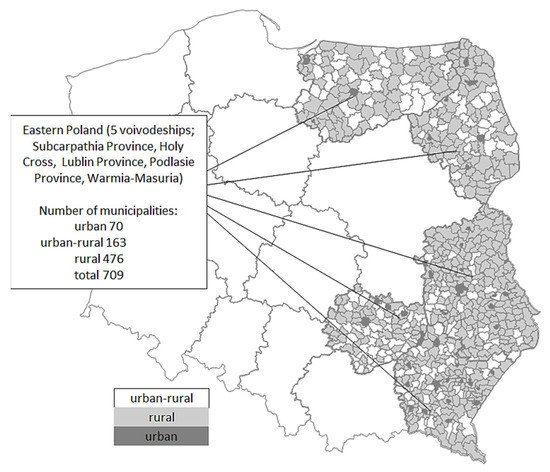
Figure 3.
Study area—communes of Eastern Poland Sources: own study.
The nature of the problems affecting the socio-economic situation and development prospects have a structural dimension and are historically conditioned. The communes in Eastern Poland are characterized by the unfavorable financial, economic condition, the low efficiency of the structure of the economy and the labor market, the outflow of inhabitants to other regions, the low level of innovation [64]. Communes (subjects of research) are the basic units of local self-government. They have legal personality. They are equipped with their own assets and income. They can freely determine the directions of spending their own income. The scope of activities of municipalities includes all public matters of local importance (not reserved for other entities), meeting the collective needs of the community, increasing attractiveness, and thus development [65].
The selected set of variables was saved as an observation matrix in the form:
where: —denotes the values of the j-th variable for the i-th object, matrix of dnaych objects, i—object number (i = 1, 2, …, n), j—variable number (j = 1, 2,. …, m).
The selected set of variables according to the main criterion (zero waste, green economy) was verified according to the statistical criterion. The coefficient of variation was written by the formula:
where, Vi—coefficient of variation for the i-th variable, Si—standard deviation for the i-th variable, is the arithmetic mean of the i-th variable.
Diagnostic variables that do not satisfy the inequality where V* is the critical value of the coefficient of variation (=0.10), were removed from the set [60]. The selected diagnostic variables are characterized by sufficient spatial variability. For the analysis of the selected set of variables, the following were also used: minimum, maximum, positional coefficient of variation, standard and quarter deviation, asymmetry, and kurtosis.
Standardization of features, according to zero unitarization method: stage 2.
Selected diagnostic variables are referred to as stimulants and destimulants [66,67]. If it is difficult to define the nature of the variable (in relation to the main criterion), it is worth using Grabiński’s procedure. It takes advantage of the fact that stimulants should be positively correlated with stimulants (such as destimulants with destimulants) and negatively with destimulants. For stimulants, the direction of correlation between the variable and the decision variable should be positive, and for destimulants, we should say the reverse [68,69].
In the process of standardizing variables, the method used a zeroed unitization procedure. Its aim is to replace the varying ranges of variation of individual variables with a fixed range. In the method is a fixed reference point, which is the gap:
R(Xj) = maxixij − minixij,
Diagnostic variables (selected for the construction of a synthetic measure) usually have different titles, which makes it impossible to compare and add them directly [60,70]. The variables were normalized depending on their types, according to the following formulas [71,72,73,74]:
where maxixij ≠ minixij, maxixij > minixij, S-stymulanta, D-destymulanta, i = 1, 2, …, n; j = 1, 2, …, m, maxixij—the maximum value of the j-th variable, minixij—the minimum value of the j-th variable [56,75], xij—means the value of the j-th variable for the i-object [76,77], and Zij the normalization value of the j-th variable for the i- of this object (belongs to the interval [0; 1]) [78,79].
As a result of unitarization ({Zij} = {S}∪{D}), we obtain a matrix of feature values (unified with regard to the range of variability and location in the observation space), written in the form:
where Zij is the unitary value of the j-th variables for the i-th object.
Aggregating the value of a synthetic measure: stage 3.
In the assessment of spatial differentiation of waste management (zero waste) and green economy, a synthetic measure was used based on the technique for order preference by similarity to an ideal solution (TOPSIS) method. It enables a multidimensional and comprehensive look at the level of the studied phenomenon in spatial and temporal terms, as well as their linear ordering [80,81]. It allows for the assessment and comparison of the analyzed objects and indicates weaker and better areas of the unit’s operation [82,83,84,85,86]. The first synthetic measure of development was proposed by Z. Hellwig [71].
The method of linear ordering technique for order preference by similarity to an ideal solution is a model method in which two points of reference are determined - a standard and an anti-pattern [87,88,89]. The Euclidean distances of the objects from the standard and anti-standard were successively calculated, according to the formulas:
- (a)
- distances of objects from the pattern:
- (b)
- distances of objects from the anti-pattern:
The synthetic measure for individual objects according to the TOPSIS method was determined on the basis of the formula:
with the proviso that: ∈ [0; 1]; - means the distance of the object from the anti-pattern (from 0), means the distance of the object from the pattern (from 1). A higher value of the measure indicates a better situation of an individual in the analyzed area [85,90,91,92,93].
Linear ordering, assessment of the relationship of diagnostic variables with a synthetic measure, assessment of the similarity and concentration of the phenomenon: stage 4.
The value of the synthetic measure made it possible to divide the studied collective into typological groups. The subdivision was made based on the first, second, and third quartiles. They represented threshold values for the group. The units belonging to the first group were characterized by a higher value of the measure (better situation in the studied area). The following groups included weaker [66,94,95].
The assessment of similarity or dissimilarity was made on the basis of the Euclidean distance. The distance between the objects cannot be negative. At a distance of 0, the objects are identical. The farther away from each other, the more dissimilar the objects are (=1). The similarity matrix was determined in the PQStat program. The Euclidean distance between two points is equal to the length of the segment connecting these points.
The scattering plot and the bag plot presented on the basis of the synthetic measure made it possible to show the differentiation of the units of the studied population and the outliers (the charts were made in the Statistica program).
For the analysis and evaluation of the strength of the relationship between the variables and the synthetic measure, Pearson’s linear correlation coefficients were used (the analyzes were performed in the Grtel software).
The concentration factor (Gini) was calculated in the Statistica program. It is a measure of the inequality of the distribution of the studied variable and takes a value between 0 (indicates no inequality) and 1 (indicates complete inequality). If the observations for yi are ordered in ascending order, then the Gini coefficient is given by the formula:
where: yi is the value of the i observation, and is the average value of all yi observations [96,97].
4. Results
The contemporary resource management model is not sustainable. It puts pressure on the environment. Human activities in various spheres of his activity generate specific amounts of waste. They influence the quality and changes of the natural environment. The activities of local units, including authorities and residents, should be focused on preventing waste generation, limiting its amount, ensuring recovery, and neutralizing waste. The concepts of green economy and zero waste assume the preservation of the values of the natural environment for the society. The waste management system creates conditions ensuring the transformation of the economy towards a green economy. There is a need to monitor the condition of the local economy.
The synthetic measure of green economy ranged from 0.28 to 0.56 in 2010, from 0.28 to 0.59 in 2020. In the analyzed period 2010–2020, there was no change in the smallest value (0.28–0.28), whereas in the case of the highest measure, we observe an increase of 0.05 (0.56–0.59); and in the case of the waste management measure from 0.19 to 0.55 in 2010 and 0.32 to 0.53 in 2020. In the case of the lowest value in relation to 2010 to 2020, we observe an increase (0.19–0.32; 0.68), and in the largest measure a decrease −0.04 (0.55–0.53). Figure 4 indicates greater stability in terms of the green economy measure, with greater differentiation of the waste management measure.
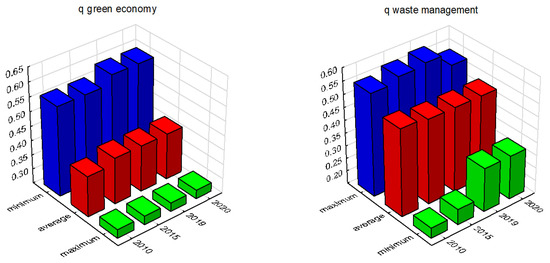
Figure 4.
The range of the synthetic measure, waste management and green economy in communes of Eastern Poland in 2010–2020. Source: own study.
Figure 5 shows the classification due to the synthetic measure -green economy and waste management. The back color marked a group of municipalities characterized by a better situation in the studied area (higher value of the synthetic measure). Lighter color indicates weaker units (lower value of the synthetic measure).
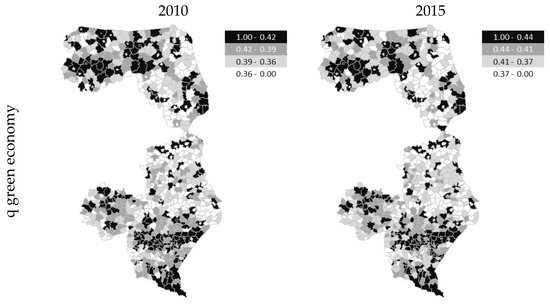
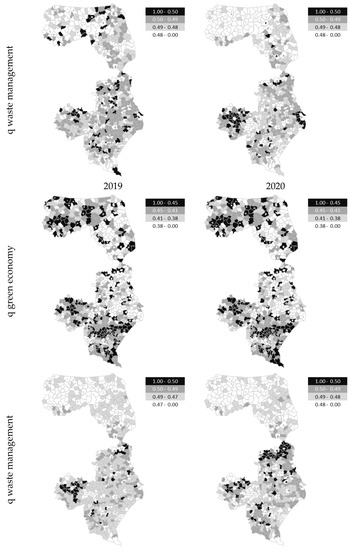
Figure 5.
Spatial differentiation of the measure of waste management and green economy in communes of Eastern Poland in 2010–2020. Source: own study.
The similarity or dissimilarity of units in the main criterion under study was expressed using the Euclidean distance. We observe a greater degree of unit differentiation in the green economy measure (2010/2015—0.37; 2015/2019—0.40; 2019/2020—0.43), lower waste management (0.09; 0.10; 0.23). The statistical characteristics of the synthetic measure, green economy, and waste management in communes of eastern Poland in 2010–2020 indicate changes in the differentiation (Table 2). Standard deviation indicates the relative constancy of units in the aspect studied. The coefficient of variation, the range show a decrease in the differentiation in terms of green economy, an increase in the aspect of waste management. The higher the kurtosis, the greater the concentration of the population around the mean value (the smaller the values the greater the spread, weaker concentration, flattening the abundance curve). In the case of the green economy measure, we observe left-hand skewness (As < 0) and the right-hand waste management measure (As > 0). Left-hand skew indicates that a greater number of units have values for these variables greater than their mean (right-hand inverse).

Table 2.
Statistical characteristics of the synthetic measure, waste management and green economy in communes of Eastern Poland in 2010–2020.
The Pearson correlation coefficient between the value of the synthetic measure of communes in eastern Poland is presented in Figure 6. Higher correlation indicators in the year-on-year relation are observed in the case of green economy (0.933; 0.972; 0.989, respectively) and lower waste management (0.688; 0.838; 0.892).
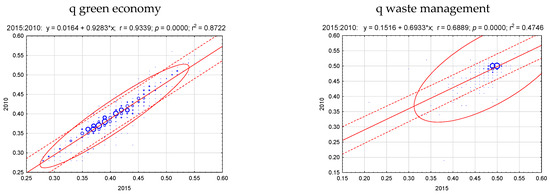
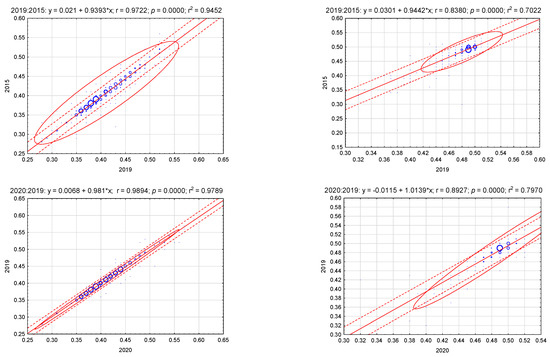
Figure 6.
Spread of the synthetic measure, waste management and green economy in communes of Eastern Poland in 2010–2020. Source: own study.
In the case of the relationship between the synthetic measure, green economy, and waste management, as shown in Figure 7, we observe negative values (−0.494; −0.468; −0.461; −0.459; an increase in the value of one variable followed by a decrease in the value of the other). The bag chart shows groups of statistically similar municipalities (including outliers, whose graphic shape in subsequent years indicates their differentiation).

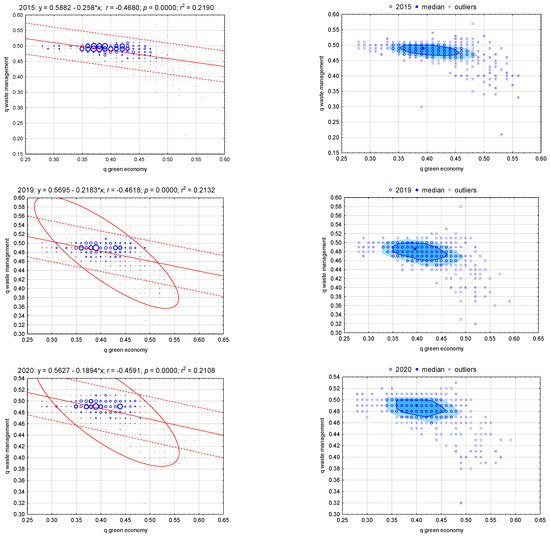
Figure 7.
Spread of the synthetic measure of waste management in relation to the green economy of communes in Eastern Poland in 2010–2020. Source: own study.
Figure 8 shows that the synthetic measure, green economy in 2020, in relation to 2020/2019, was subject to a low divergence, 0.120; and in relation to 2020/2010, 0.218. The synthetic measure of waste management ranged from −0.085 to 0.057. In the case of the relation 2020 and 2020/2019, for the measure green economy, we observe an erroneous numerical condition, i.e., a small number of different values of at least one of the variables taken into the chart. For a bag chart with colored areas to be created, there must be more values so that they are scattered on the plane.
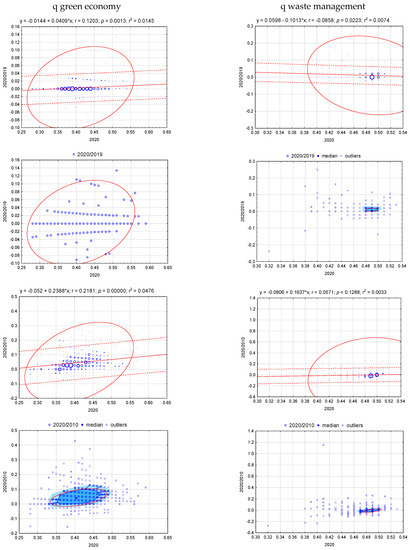
Figure 8.
Spread of the synthetic measure of waste management and green economy to the value of changes in communes in Eastern Poland in 2010–2020. Source: own study.
The interdependence of the variables presented in Figure 9 (scatter plot for objects in three-dimensional space) indicates that the synthetic measure in 2020, in relation to 2020/2010, was subject to divergence in both analyzed areas (0.654; 0.216). In the case of the relation of the measure in 2020 to the relation 2020/2019, it was 0.872 and 0.637, respectively. Hence, there was greater differentiation in terms of waste management.
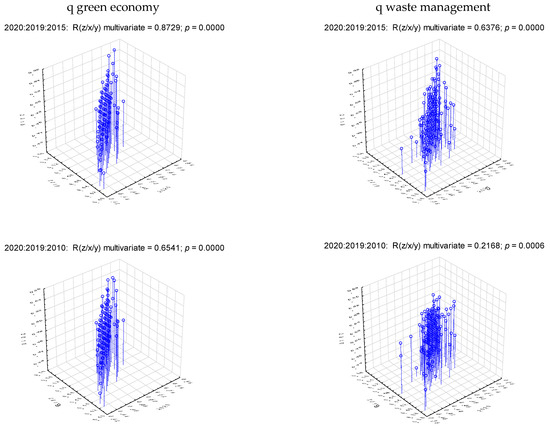
Figure 9.
Differences in the space of the three-dimensional synthetic measure, waste management and green economy in communes of Eastern Poland in 2010–2020. Source: own study.
Table 3 presents the Pearson correlation coefficient between the values of the synthetic measure and the values of diagnostic variables in 2020. The measure of waste management, green economy was positively and negatively correlated with diagnostic variables.

Table 3.
Coefficients of correlation between the value of waste management (zero west) and ecology and natural environment of poviats and their values in 2020.
The measure of the inequality of the distribution of the values of the synthetic measure of communes for the years 2010–2020 takes a value between 0 and 1. Figure 10 shows the concentration of the studied phenomenon according to the synthetic measure.
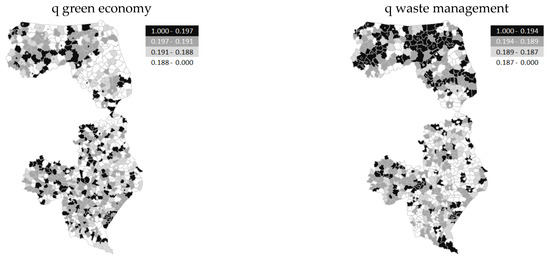
Figure 10.
Concentration of the synthetic measure, waste management and green economy in communes of Eastern Poland in 2010–2020 (Gini’s coefficient). Source: own study.
5. Discussion
While implementing economic development, we must also pay attention to environmental protection. Green growth places importance on both the environment and economic development [96]. The development of green economy means shaping the aspect of the natural environment (in line with the specificity of the local economy), shaping ecology (while ensuring economic security, quality of life), social stabilization, and creating conditions for sustainable green development. The transition to a green economy (with today’s energy crisis) is a challenge. Local economic adjustment can prevent the dangerous effects of environmental degradation and climate change. The attempt to identify the effects of green economy in the economic system indicates its particular importance for enhancing the diversity, efficiency, and adaptability of regions (which, according to the authors, is due to endogenous territorial potential, which should be the basis of the measures taken). As part of the concept of green economy, development processes and accompanying activities may be of significant importance from the perspective of strengthening the attributes of the local economy in the economic and environmental dimension, e.g., resource saving, minimizing the impact of external factors causing disruptions to regional systems, technological changes, difficulties in accessing resources and energy sources, economic recessions [97]. The key elements of the transition to a green economy are: the value of natural capital; appropriate regulations and economic incentives, appropriate environmental regulations, patterns of sustainable production and consumption, or fair distribution of income and social standards [98,99].
The concept of a green economy has been criticized for significant overlap with, or attempts to replace, sustainable development. S. Lorek and J.H. Spangenberg argue that the concept of a green economy does not support the original sustainability criteria. It goes beyond sustainability to tackle the artificial separation between the environment and the economy [100]. J. Hickel shows the pitfalls of exponential growth, i.e., the amount of steel, non-ferrous metals, food, products, and energy, all of which are subject to increasing demand. He points out that at the current rate of economic growth, a significant portion of the new capacity from renewable energy sources is used to fuel the growth itself, not to replace existing coal-fired power plants [101]. The authors of the article point out that as a multi-elemental concept, described by many diagnostic variables, green economy and waste management are difficult to clearly define and evaluate. This makes it difficult to define a model for their implementation. Processes within their framework should be implemented according to the endogenous potential of a given unit. Vuković et al. argue that green economy indicators have the properties of uncertainty and blurring or lack of rules and principles for their creation [102]. The dilemma of implementing a green economy is exposed as an elementary struggle between entities for the management of natural resources and access to them, as well as their benefits [103].
The concept of a green economy has an impact on politics in many countries (e.g., UK, France, and China) [104]. Green economy means an economy geared towards solving environmental problems of increasing pollution, the generation of excessive waste [105]. Zero waste has become the aspirational goal of solving waste problems. Adelaide, San Francisco, and Vancouver have adopted zero waste targets as part of their waste management strategies. The ZW concept stimulates sustainable production and consumption, optimal recycling, and recovery of resources [106].
There is a wider limitation of both the economic measurement and indicators for the green economy (especially access to information on green transformation processes, e.g., on the level of municipalities in Poland). Economic measurement should be supported by other types of information (e.g., in terms of demography, environment, economy). For all aspects of green economy, attention should be paid to capacity and data limitations, and to the aspect of data availability at the level of municipalities in Poland [105].
Significant differences in the production of waste (including municipal waste) were observed in the EU countries. The amount of waste produced depended on economic development. The most effective tools for dealing with waste should be to enhance reduction, reuse, and recycling behavior. Countries striving to minimize waste generation should also pay more attention to promoting sustainable consumption and production. EU citizens do not have a proper understanding of the relationship between waste reduction and the conservation of natural resources [107].
The basis of sustainable municipal waste management is the comprehensive treatment of waste, taking into account economic and environmental aspects as well as social conditions. Rational management of depleted natural resources requires treating waste as valuable raw materials. The need to change the approach to waste management also results from the need to reduce the valuable space necessary for their disposal, processing, and storage. Optimizing integrated waste management should be oriented towards economic, environmental, and energy (3E) goals in the conditions of the deep complexity of the green transformation of the economy [108].
The ZW concept fits in with a circular economy where resources are used instead of creating waste [109]. A holistic doctrine of the circular economy, consisting in the reduction of environmentally harmful waste and keeping the raw materials in circulation as long as possible [110]. Waste management plays a key role in the circular economy [111].
The analysis of data from countries (Poland, Slovakia, Ukraine) showed a significant relationship between the basic elements of everyday functioning of households related to environmental protection through responsible consumption, reuse, and recovery of selected products, packaging, and materials, as well as food and the zero waste concept [112].
Problems related to municipal waste management in Poland include the slowly decreasing amount of municipal waste. At the same time, there is an insufficient development of the selective collection and recycling system, an increase in the number of illegal landfills, and insufficient protection of landfills. In accordance with the principle of sustainable development, waste should be reused [113]. The best way to manage waste is to reduce its amount by reusing it (recycling). In the case of municipal waste, selective collection concerns mainly the collection of secondary raw materials, such as paper, glass, plastics, and metals [114]. Relevant efforts to develop a sustainable, integrated waste management system will vary depending on the local situation [115].
In Croatia and Slovenia, the transition to a greener economy is positive. In Bosnia and Herzegovina, Serbia and Slovenia, the lack of adequate policy and awareness and the ineffective allocation of external resources remain barriers to such a greener transformation [116]. The recycling rate, which is one of the measures of the goals of the circular economy, is of particular importance. One of the leaders is Slovenia, which present a recycling rate at the level of highly developed countries, i.e., more than twice as high as Poland [117].
Waste is a symbol of the inefficiency of any modern society and a representation of misallocated resources. To prevent further depletion of resources, we need sustainable consumption and strategic waste management systems based on waste avoidance, material efficiency, and resource recovery [118].
6. Conclusions
In spatial terms, the essence of green economy, or zero waste, results from striving to reduce the burden on the natural environment, creating attractive conditions for life and business activity. The development of a green economy means shaping the aspect of the natural environment (in line with the specifics of the local economy) while ensuring economic security, quality of life, intertwined stabilization, and creating conditions for sustainable green development. The transition to a green economy (with the contemporary energy crisis) is a challenge for the local economy.
The spatial differentiation of the development of communes suggests the existence of an impact of natural conditions on social and economic conditions, and thus on the process of transformation towards a green economy. Given the condition and structure of the local economy and the quality of life, waste management (its structure and quantity) of the local community may constitute a barrier to the development of the green economy of communes.
In the era of the network economy, communes must shape their potential. This process is an inseparable element of their development and functions on many levels distinguished by economic, cultural, social, and spatial (natural) features. Resources, including the natural, economic, and social environment and infrastructure used in economic and social relations, are interdependent and occur at the same time. There is a correlation between them, and they should be considered together.
The results of grouping may be a stimulus for further, in-depth research aimed at determining which variables have a decisive impact on the transformation process towards a green economy and zero waste. Further empirical research is needed on the implementation of zero waste, green economy, and the relationship with the variables of demography, financial situation, and environmental changes.
The added value of the article is the results of the research focused on the evaluation of the relationship between the waste management and green economy of municipalities in eastern Poland in 2010–2020. The authors treated the synthetic measure used as an instrument for monitoring and modeling the operation of municipalities, as a measure of the choice of actions taken, or a measure of the economic situation of municipalities. A systematic study of green economy or waste management should provide the information necessary for authorities to assess and correct the policies pursued and the disparities occurring between units or areas of operation. For inter-regional comparisons, it should include the same variables in the indicated surveyed areas.
Author Contributions
Conceptualization, P.D., A.W. and P.P.; methodology, P.D., A.W. and P.P.; software, P.D., A.W. and P.P.; validation, P.D., A.W. and P.P.; formal analysis, P.D., A.W., P.P., A.P., M.M. and M.W.; investigation, P.D., A.W., P.P., A.P., M.M. and M.W.; resources, P.D., A.W., P.P., A.P., M.M. and M.W.; data curation, P.D., A.W., P.P., A.P., M.M. and M.W.; writing—original draft preparation, P.D., A.W., P.P., A.P., M.M. and M.W.; writing—review and editing, P.D., A.W., P.P., A.P., M.M. and M.W.; visualization, P.D., A.W., P.P., A.P., M.M. and M.W.; supervision, P.D., A.W., P.P., A.P., M.M. and M.W.; project administration, P.D., A.W., P.P., A.P., M.M. and M.W.; funding acquisition, P.D., A.W., P.P., A.P., M.M. and M.W. All authors have read and agreed to the published version of the manuscript.
Funding
This research received no external funding.
Conflicts of Interest
The authors declare no conflict of interest.
References
- Stanny, M. Zróżnicowanie poziomu rozwoju obszarów wiejskich w Polsce a problem realizacji polityki spójności. Wieś I Rol. 2009, 4, 246–257. [Google Scholar]
- Główny Urząd Statystyczny, Urząd Statystyczny w Białymstoku. In Wskaźniki Zielonej Gospodarki w Polsce 2020; Główny Urząd Statystyczny, Urząd Statystyczny w Białymstoku: Warszawa, Poland; Białystok, Poland, 2020.
- A Toolkit of Policy Options to Support Inclusive Green Growth. OECD. Available online: https://www.undp.org/sites/g/files/zskgke326/files/publications/IGG-ToolkitAfDB-OECD-UN-WB-revised_July_2013.pdf (accessed on 13 November 2022).
- Towards a Green Economy: Pathways to Sustainable Development and Poverty Eradication. UNEP (United Nations Environment Programme). Available online: https://sustainabledevelopment.un.org/content/documents/126GER_synthesis_en.pdf (accessed on 13 November 2022).
- OECD. Interim Report of the Green Growth Strategy: Implementing our Commitment for a Sustainable Future. In Proceedings of the Meeting of the OECD Council at Ministerial Level, Paris, France, 27–28 May 2010. [Google Scholar]
- Sun, X. Green city and regional environmental economic evaluation based on entropy method and GIS. Environ. Technol. Innov. 2021, 23, 101667. [Google Scholar] [CrossRef]
- Lombardi, E. Zero Landfill is not Zero waste. BioCycle Mag. 2011, 52, 44. [Google Scholar]
- Czaplicka-Kolarz, K.; Kruczek, M. Wybrane aspekty gospodarki odpadami komunalnymi w województwie śląskim. Zesz. Nauk. Politech. Śląskiej 2018, 121, 61–73, Seria: Organizacja i Zarządzanie z. [Google Scholar]
- Parysek, J.J. Podstawy Gospodarki Lokalnej; Wydawnictwo Naukowe Uniwersytetu Adama Mickiewicza: Poznań, Poland, 2001. [Google Scholar]
- Brol, R. Rozwój lokalny—Nowa logika rozwoju gospodarczego. Pr. Nauk. Akad. Ekon. We Wrocławiu 1998, 785, 11–15. [Google Scholar]
- OECD. Towards Green Growth: Monitoring Progress OECD Indicators; OECD: Paris, France, 2011. [Google Scholar]
- Verma, S.; Kandpal, D. Green Economy and Sustainable Development: A Macroeconomic Perspective. In Environmental Sustainability and Economy; Singh, P., Verma, P., Perrotti, D., Srivastava, K.K., Eds.; Elsevier: Amsterdam, The Netherlands, 2021; pp. 325–343. [Google Scholar] [CrossRef]
- Ryszawska, B. Zielona Gospodarka w dokumentach strategicznych Unii Europejskiej. Ekon. I Sr. 2013, 3, 26–37. [Google Scholar]
- OECD. Applications of Complexity Science for Public Policy; OECD: Paris, France, 2009. [Google Scholar]
- United Nations. Contribution by the European Union and its Member States. In Proceedings of the UN Conference RIO+20, United Nations Conference on Sustainable Development, Rio de Janeiro, Brazil, 20–22 June 2012. [Google Scholar]
- Hahnel, R. Green Economics: Confronting the Ecological Crisis; M.E. Sharpe: New York, NY, USA, 1998. [Google Scholar]
- Dabyltayeva, N.; Rakhymzhan, G. The Green Economy Development Path: Overview of Economic Policy Priorities. J. Secur. Sustain. Issues 2019, 8, 643–651. [Google Scholar] [CrossRef]
- Allen, C.; Clouth, S. A Guidebook to the Green Economy; UNDESA: New York, NY, USA, 2012; pp. 6–8. [Google Scholar]
- Green Economy Definition. Available online: https://greeneconomygroup.com/company/green-economy-definition/ (accessed on 14 November 2022).
- Ayres, R.; van der Lugt, C. Manufacturing. Investing in Energy and Resource Eficiency. In Green Economy Report, Towards a Green Economy: Pathways to Sustainable Development and Poverty Eradication; UNEP: Athens, Greece, 2011. [Google Scholar]
- Mikhno, I.; Koval, V.; Shvets, G.; Garmatiuk, O.; Tamošiūnienė, R. Green Economy in Sustainable Development and Improvement of Resource Efficiency. Central Eur. Bus. Rev. 2021, 10, 99–113. [Google Scholar] [CrossRef]
- Berger, R. Strategy Consultants Gmbh. Green Growth, Green Profit: How Green Transformation Boosts Business; Palgrave Macmillan: Basingstoke, UK, 2011; p. 21. [Google Scholar]
- Newton, A.C. The green economy and the knowledge economy: Exploring the interface. Int. J. Green Econ. 2011, 5, 231. [Google Scholar] [CrossRef]
- UNEP; Green Growth; OECD. Strategia Europa. In Global Green New Deal, Green Economy; UNEP: Nairobi, Kenya; OECD: Paris, France, 2020. [Google Scholar]
- WWF. International Chamber of Commerce Living Planet Report 2010, Biodiversity, biocapacity and development. In Green Economy Roadmap. A Guide for Bussiness, Policymakers and Society; WWF International: Gland, Switzerland, 2010. [Google Scholar]
- Elimam, H. How Green Economy Contributes in Decreasing the Environment Pollution and Misuse of the Limited Resources. Environ. Pollut. 2017, 6, 10. [Google Scholar] [CrossRef][Green Version]
- Venkata Mohan, S.; Modestra, J.A.; Amulya, K.; Butti, S.K.; Velvizhi, G. Biogospodarka o obiegu zamkniętym z bioproduktami z sekwestracji CO2. Trendy Biotechnol. 2016, 34, 506–519. [Google Scholar] [CrossRef] [PubMed]
- Godlewska, J.; Sidorczuk-Pietraszko, E. Taxonomic Assessment of Transition to the Green Economy in Polish Regions. Sustainability 2019, 11, 5098. [Google Scholar] [CrossRef]
- Cato, M.S. Green Economics: An Introduction to Theory, Policy and Practice; Earthscan: London, UK, 2009. [Google Scholar]
- Domański, R. Gospodarka Przestrzenna; Wydawnictwo Naukowe PWN: Warszawa, Poland, 2002. [Google Scholar]
- Green Economy: Future Of World Economy. Available online: https://mittikerang.medium.com/green-economy-future-of-world-economy-ebc399778c21 (accessed on 14 November 2022).
- Aldieri, L.; Vinci, C.P. Green Economy and Sustainable Development: The Economic Impact of Innovation on Employment. Sustainability 2018, 10, 3541. [Google Scholar] [CrossRef]
- Genovese, A.; Acquaye, A.A.; Figueroa, A.; Koh, S.C.L. Sustainable supply chain management and the transition towards a circular economy: Evidence and some applications. Omega 2017, 66, 344–357. [Google Scholar] [CrossRef]
- Yong, R. The circular economy in China. J. Mater. Cycles Waste Manag. 2007, 9, 121–129. [Google Scholar] [CrossRef]
- D’Amato, D.; Droste, N.; Allen, B.; Kettunen, M.; Lähtinen, K.; Korhonen, J.; Leskinen, P.; Matthies, B.D.; Toppinen, A. Green, circular, bio economy: A comparative analysis of sustainability avenues. J. Clean. Prod. 2017, 168, 716–734. [Google Scholar] [CrossRef]
- Degórski, M. Gospodarka o obiegu zamkniętym circular economy—Nowe podejście w rozumieniu relacji człowiek–środowisko. Studia KPZK 2018, 183, 27–35, (Teoretyczne i aplikacyjne wyzwania współczesnej geografii społeczno-ekonomicznej). [Google Scholar]
- Santeramo, F.G. Circular and green economy: The state of the art. Heliyon 2022, 8, e09297. [Google Scholar] [CrossRef]
- Zero Waste-Co to Jest? Available online: https://www.jozefow.pl/zero-waste-co-to-jest-1488 (accessed on 14 November 2022).
- Ozga, P. Gospodarka odpadami a stan zanieczyszczenia środowiska naturalnego w Polsce w 2015 roku. Przegląd Reg. Metod. Ilościowe W Bad. Ekon. 2017, 18, 304–313. [Google Scholar] [CrossRef]
- Zaman, A.U. Identification of key assessment indicators of the zero waste management systems. Ecol. Indic. 2014, 36, 682–693. [Google Scholar] [CrossRef]
- Pietzsch, N.; Ribeiro, J.L.D.; de Medeiros, J.F. Benefits, challenges and critical factors of success for Zero Waste: A systematic literature review. Waste Manag. 2017, 67, 324–353. [Google Scholar] [CrossRef] [PubMed]
- Michniewska, K.; Grodkiewicz, P. Zero odpadów-utopia czy rozwiązanie zbyt rozwiniętego konsumeryzmu? Logistyka Odzysku 2017, 2, 39–43. [Google Scholar]
- Song, Q.; Li, J.; Zeng, X. Minimizing the increasing solid waste through zero waste strategy. J. Clean. Prod. 2015, 104, 199–210. [Google Scholar] [CrossRef]
- Lysenko, K. Zrównoważona gospodarka odpadami na przykładzie Rzeszowa. Stud. Miej. 2004, 15, 31–41. [Google Scholar]
- Shpak, N.; Kuzmin, O.; Melnyk, O.; Ruda, M.; Sroka, W. Implementation of a Circular Economy in Ukraine: The Context of European Integration. Resources 2020, 9, 96. [Google Scholar] [CrossRef]
- Kumar, S.; Vardhan Bhati, H. Waste Management to Zero Waste: Global Perspectives and Review of Indian Law and Policy. In Emerging Trends to Approaching Zero Waste; Mustansar Hussain, C.H., Singh, S., Goswami, L., Eds.; Elsevier: Amsterdam, The Netherlands, 2022; pp. 79–101. [Google Scholar]
- Singh, P.P. Solid Waste Management Through the Concept of Zero Waste. In Emerging Trends to Approaching Zero Waste; Mustansar Hussain, C.H., Singh, S., Goswami, L., Eds.; Elsevier: Amsterdam, The Netherlands, 2022; pp. 293–318. [Google Scholar]
- Burlakovs, J.; Jani, Y.; Kriipsalu, M.; Vincevica-Gaile, Z.; Kaczala, F.; Celma, G.; Ozola, R.; Rozina, L.; Rudovica, V.; Hogland, M.; et al. On the way to ‘zero waste’ management: Recovery potential of elements, including rare earth elements, from fine fraction of waste. J. Clean. Prod. 2018, 186, 81–90. [Google Scholar] [CrossRef]
- Vargas-Merino, J.A.; Rios-Lama, C.A.; Panez-Bendezú, M.H. Circular Economy: Approaches and Perspectives of a Variable with a Growing Trend in the Scientific World—A Systematic Review of the Last 5 Years. Sustainability 2022, 14, 14682. [Google Scholar] [CrossRef]
- Ustawa z dnia 14 grudnia 2012 r. O Odpad. Dz. U. 2013, 21.
- Grzymała, Z. (Ed.) Wydatki na Usługi Komunalne w Strukturze Wydatków Mieszkańców Gmin—Ocena w Układzie Regionalnym; SGH: Warszawa, Poland, 2015. [Google Scholar]
- Famielec, J. Gospodarka Odpadami Komunalnymi Jako Działalność Gospodarcza Realizowana w Ogólnym Interesie Gospodarczym. In Pomoc Publiczna. Doświadczenia Wybranych Sektorów Gospodarki; Kożuch, M., Ed.; Fundacja Uniwersytetu Ekonomicznego w Krakowie: Kraków, Poland, 2017. [Google Scholar]
- Amaral, R.E.; Brito, J.; Buckman, M.; Drake, E.; Ilatova, E.; Rice, P.; Sabbagh, C.; Voronkin, S.; Abraham, Y.S. Waste Management and Operational Energy for Sustainable Buildings: A Review. Sustainability 2020, 12, 5337. [Google Scholar] [CrossRef]
- Strahl, D. Możliwości wykorzystania miar agregatowych do oceny konkurencyjności regionów. Pr. Nauk. Akad. Ekon. We Wrocławiu 2020, 860, 106–120. [Google Scholar]
- Zeliaś, A. (Ed.) Ekonometria Przestrzenna; Wydawnictwo Ekonomiczne: Warszawa, Poland, 1991. [Google Scholar]
- Młodak, A. Analiza Taksonomiczna w Statystyce Regionalnej; Difin: Warszawa, Poland, 2006. [Google Scholar]
- Malina, A.; Zieliaś, A. Taksonomiczna Analiza Przestrzennego Zró żnicowania Jakości Życia Ludności w Polsce w 1994 r. In Ekonometryczne Modelowanie Danych Finansowo-Księgowych; Nowak, E., Urbaniak, M., Eds.; UMCS: Lublin, Poland, 1996; pp. 85–89. [Google Scholar]
- Kukuła, K.; Luty, L. O wyborze metody porządkowania liniowego do oceny gospodarki odpadami w Polsce w ujęciu przestrzennym. Zesz. Nauk. Szkoły Głównej Gospod. Wiej. W Warszawie 2018, 18, 183–192. [Google Scholar] [CrossRef]
- Malina, A.; Zeliaś, A. O budowie taksonomicznej miary jakości życia. Syntetyczna miara rozwoju jest narzędziem statystycznej analizy porównawczej. Taksonomia 1997, 4, 238. [Google Scholar]
- Malina, A. Wielowymiarowa Analiza Przestrzennego Zróżnicowania Struktury Gospodarki Polski Według Województw. Akademii Ekonomicznej w Krakowie: Krakow, Poland, 2004; pp. 96–97. [Google Scholar]
- Chojnicki, Z.; Czyż, T. Problemy metodologiczne zastosowania analizy czynnikowej w geografii. Przegląd Geogr. 1975, 47, 3. [Google Scholar]
- Adamowicz, M.; Janulewicz, P. Wykorzystanie analizy czynnikowej do oceny rozwoju społeczno-gospodarczego w skali lokalnej. Pr. Nauk. Uniw. Ekon. We Wrocławiu 2013, 305, 15–23. [Google Scholar]
- Malina, A. Analiza czynnikowa jako metoda klasyfi kacji regionów Polski. Przegląd Stat. 2006, 53, 33–48. [Google Scholar]
- Program Operacyjny Polska Wschodnia 2014-2020 (POPW). Available online: https://www.funduszeeuropejskie.gov.pl/media/109416/POPW_20220628.pdf (accessed on 14 November 2022).
- Ustawa z dnia 8 marca 1990 r. O Samorz. Gm. 2001, 142, 1591.
- Wysocki, F. Metody Taksonomiczne w Rozpoznawaniu Typów Ekonomicznych Rolnictwa i Obszarów Wiejskich; Wyd. Uniwersytetu Przyrodniczego w Poznaniu: Poznań, Poland, 2010. [Google Scholar]
- Łuczak, A.; Wysocki, F. Wykorzystanie Metod Taksonometrycznych i Analitycznego Procesu Hierarchicznego do Programowania rozwoju Obszarów Wiejskich; Wydawnictwo Akademii Rolniczej im. Augusta Cieszkowskiego w Poznaniu: Poznań, Poland, 2005. [Google Scholar]
- Grabiński, T. Metody określania charakteru zmiennych w wielowymiarowej analizie porównawczej. Zesz. Nauk. Akad. Ekon. W Krakowie 1985, 213, 35–63. [Google Scholar]
- Grabiński, T.; Wydymus, S.; Zeliaś, A. Metody Taksonomii Numerycznej w Modelowaniu Zjawisk Społeczno-Gospodarczych; PWN: Warszawa, Poland, 1989. [Google Scholar]
- Walesiak, M. Problemy selekcji i ważenia zmiennych w zagadnieniu klasyfikacji. Pr. Nauk. AE We Wroc. 2005, 12, 106–118. [Google Scholar]
- Hellwig, Z. Zastosowanie metody taksonomicznej do typologicznego podziału krajów ze względu na poziom ich rozwoju oraz zasoby i strukturę wykwalifikowanych kadr. Przegląd Stat. 1968, 4, 307–326. [Google Scholar]
- Hellwig, Z. Taksonometria Ekonomiczna, jej Osiągnięcia, Zadania i Cele, w: Taksonomia—Teoria i jej Zastosowania; Akademia Ekonomiczna w Krakowie: Kraków, Poland, 1990. [Google Scholar]
- Rogowski, W.; Krysiak, M. Zastosowanie metody wzorca do tworzenia klas ryzyka kredytowego. Bank I Kredyt 1997, 7–8, 92–103. [Google Scholar]
- Kukuła, K. Metoda Unitaryzacji Zerowanej; Wyd. Naukowe PWN: Warszawa, Poland, 2000. [Google Scholar]
- Wysocki, F.; Lira, J. Statystyka Opisowa; Wyd. AR: Poznań, Poland, 2005. [Google Scholar]
- Prus, P.; Dziekański, P.; Bogusz, M.; Szczepanek, M. Spatial Differentiation of Agricultural Potential and the Level of Development of Voivodeships in Poland in 2008–2018. Agriculture 2021, 11, 229. [Google Scholar] [CrossRef]
- Dziekański, P.; Prus, P. Financial Diversity and the Development Process: Case study of Rural Communes of Eastern Poland in 2009–2018. Sustainability 2020, 12, 6446. [Google Scholar] [CrossRef]
- Kukuła, K. Metoda unitaryzacji zerowanej na tle wybranych metod normowania cech diagnostycznych. Acta Sci. Acad. Ostroviensis 1999, 4, 5–31. [Google Scholar]
- Kukuła, K.; Bogocz, D. Zero Unitarization, Method and Its Application in Ranking Research in Agriculture. Econ. Reg. Stud. 2014, 7, 5–13. [Google Scholar]
- Lenormand, M.; Deffuant, G. Generating a Synthetic Population of Individuals in Households: Sample-Free Vs Sample-Based Methods. J. Artif. Soc. Soc. Simul. 2013, 16, 1–12. [Google Scholar] [CrossRef]
- Malina, A. Analiza przestrzennego zróżnicowania poziomu rozwoju społeczno-gospodarczego województw Polski w latach 2005–2017. Soc. Inequalities Econ. Growth 2020, 61, 138–155. [Google Scholar] [CrossRef]
- Kozak, J.M.; Mrówczyńska-Kamińska, A.; Wołoszyn, A. Multidimensional assessment of the financial position of polish households and its regional diversity. Heliyon 2022, 8, e09483. [Google Scholar] [CrossRef] [PubMed]
- Sompolska-Rzechuła, A.; Kurdyś-Kujawska, A. Assessment of the Development of Poverty in EU Countries. Int. J. Environ. Res. Public Health 2022, 19, 3950. [Google Scholar] [CrossRef]
- Vavrek, R.; Papcunová, V.; Tej, J. Evaluation of Financial Management of Towns in relation to Political Cycles using CV-TOPSIS. Lex localis-J. Local Self-Government 2020, 18, 231–252. [Google Scholar] [CrossRef]
- Velasquez, M.; Hester, P.T. An Analysis of Multi-Criteria Decision Making Methods. Int. J. Oper. Res. 2013, 2, 56–66. [Google Scholar]
- Kim, Y.; Chung, E.S.; Jun, S.M.; Kim, S.U. Prioritizing the best sites for treated wastewater instream use in an urban watershed using fuzzy {TOPSIS}. Resour. Conserv. Recycl. 2013, 73, 23–32. [Google Scholar] [CrossRef]
- Wójcik-Leń, J.; Leń, P.; Mika, M.; Kryszk, H.; Kotlarz, P. Studies regarding correct selection of statistical methods for the needs of increasing the efficiency of identification of land for consolidation—A case study in Poland. Land Use Policy 2019, 87, 104064. [Google Scholar] [CrossRef]
- Bąk, A. Zastosowanie metod wielowymiarowej analizy porównawczej do oceny stanu środowiska w województwie dolnośląskim. Wiadomości Stat. 2018, 1, 7–20. [Google Scholar]
- Behzadian, M.; Otaghsara, S.K.; Yazdani, M.; Ignatius, J. A state-of the-art survey of TOPSIS applications. Expert Syst. Appl. 2012, 39, 13051–13069. [Google Scholar] [CrossRef]
- Hwang, C.L.; Yoon, K. Multiple Attribute Decision Making: Methods and Applications; Springer: Berlin, Germany, 1981. For: Bieniasz, A.; Gołaś, Z.; Łuczak, A. Zróżnicowanie kondycji finansowej gospodarstw rolnych wyspecjalizowanych w chowie owiec i kóz w krajach Unii Europejskiej. Rocz. Ekon. Rol. I Rozw. Obsz. Wiej. 2013, 100, 1. [Google Scholar]
- Jahanshahloo, G.R.; Lotfi, F.H.; Izadikhah, M. An Algorithmic Method to Extend {TOPSIS} for Decision-Making Problems with Interval Data. Appl. Math. Comput. 2006, 2, 1375–1384. [Google Scholar] [CrossRef]
- Özkan, B.; Özceylan, E.; Kabak, M.; Dikmen, A.U. Evaluation of criteria and COVID-19 patients for intensive care unit admission in the era of pandemic: A multi-criteria decision making approach. Comput. Methods Programs Biomed. 2021, 209, 106348. [Google Scholar] [CrossRef]
- Kozera, A.; Dworakowska-Raj, M.; Standar, A. Role of Local Investments in Creating Rural Development in Poland. Energies 2021, 14, 1748. [Google Scholar] [CrossRef]
- Krukowska, D. Makrospołeczne Determinanty Dystrybucji Dochodów. In Zróżnicowanie Społeczne w Perspektywie Porównawczej; Wesołowski, W., Słomczyński, K., Eds.; Zakł. Narod. im. Osolińskich: Wrocław, Poland, 1981. [Google Scholar]
- Makarewicz-Marcinkiewicz, A. Nierówności Społeczne na Drodze do Zrównoważonego Rozwoju. Problem Polityki Społecznej i Gospodarczej; Wydawnictwo Adam Marszałek: Toruń, Poland, 2015. [Google Scholar]
- Cui, L.; Mu, Y.; Shen, Z.; Wang, W. Energy transition, trade and green productivity in advanced economies. J. Clean. Prod. 2022, 361, 132288. [Google Scholar] [CrossRef]
- Drobniak, A.; Janiszek, M.; Plac, K. Zielona gospodarka i zielona infrastruktura jako mechanizmy wzmacniania gospodarczo-środowiskowego wymiaru prężności. Res. Pap. Wrocław Univ. Econ. 2016, 443, 57–69. [Google Scholar]
- Loiseau, E.; Saikku, L.; Antikainen, R.; Droste, N.; Hansjürgens, B.; Pitkänen, K.; Thomsen, M. Green economy and related concepts: An overview. J. Clean Prod. 2016, 139, 361–371. [Google Scholar] [CrossRef]
- Mardani, A.; Streimikiene, D.; Nilashi, M.; Aranda, D.A.; Loganathan, N.; Jusoh, A. Energy consumption, economic growth, and CO2 emissions in G20 countries: Application of adaptive neuro-fuzzy inference system. Energies 2018, 11, 2771. [Google Scholar] [CrossRef]
- Lorek, S.; Spangenberg, J.H. Sustainable consumption within a sustainable economy—Beyond green growth and green economies. J. Clean. Prod. 2014, 63, 33–44. [Google Scholar] [CrossRef]
- Hickel, J. Less is More: How Degrowth Will Save the World (Mniej Znaczy Lepiej. O Tym jak Odejście od Wzrostu Gospodarczego Ocali Świat); Wyd. Karakter: Krakow, Poland, 2021. [Google Scholar]
- Vukovic, N.; Pobedinsky, V.; Mityagin, S.; Drozhzhin Mingaleva, Z. A Study on Green Economy Indicators and Modeling: Russian Context. Sustainability 2019, 11, 462. [Google Scholar] [CrossRef]
- Swainson, L.; Mahanty, S. Green economy meets political economy: Lessons from the “Aceh Green” initiative, Indonesia. Glob. Environ. Chang. 2018, 53, 286–295. [Google Scholar] [CrossRef]
- Bina, O.; La Camera, F. Promise and shortcomings of a green turn in recent policy responses to the ‘double crisis’. Ecol. Econ. 2011, 70, 2308–2316. [Google Scholar] [CrossRef]
- Bailey, I.; Caprotti, F. The green economy: Functional domains and theoretical directions of enquiry. Environ. Plan. A 2014, 46, 1797–1813. [Google Scholar] [CrossRef]
- Zaman, A.U. A comprehensive review of the development of zero waste management: Lessons learned and guidelines. J. Clean. Prod. 2015, 91, 12–25. [Google Scholar] [CrossRef]
- Minelgaitė, A.; Liobikienė, G. Waste problem in European Union and its influence on waste management behaviours. Sci. Total Environ. 2019, 667, 86–93. [Google Scholar] [CrossRef]
- Liang, X.; Ji, L.; Xie, Y.; Huang, G. Economic-Environment-Energy (3E) objective-driven ntegrated municipal waste management under deep complexities—A novel multi-objective approach. Sustain. Cities Soc. 2022, 87, 104190. [Google Scholar] [CrossRef]
- Cole, C.; Osmani, M.; Quddus, M.; Wheatley, A.; Kay, K. Towards a Zero Waste Strategy for an English Local Authority. Resour. Conserv. Recycl. 2014, 89, 64–75. [Google Scholar] [CrossRef]
- Lorens, A. Ekonomia cyrkularna jako zrównoważony, odpowiedzialny proces wyrażony w architekturze i projektowaniu produktu. Builder 2021, 25, 37–39. [Google Scholar] [CrossRef]
- Deselnicu, D.C.; Militaru, G.; Deselnicu, V.; Zainescu, G.; Albu, L. Towards a circular economy–A Zero Waste programme for Europe. In Proceedings of the 7th International Conference on Advanced Materials and Systems ICAMS 2018, Bucharest, Romania, 18–20 October 2018; pp. 563–568. [Google Scholar] [CrossRef]
- Bogusz, M.; Matysik-Pejas, R.; Krasnodębski, A.; Dziekański, P. The Concept of Zero Waste in the Context of Supporting Environmental Protection by Consumers. Energies 2021, 14, 5964. [Google Scholar] [CrossRef]
- Kłos, L. Gospodarka odpadami komunalnymi—wyzwanie xxi wieku. Zesz. Nauk. Uniw. Szczecińskiego. Stud. I Pr. Wydziału Nauk. Ekon. I Zarządzania 2012, 28, 131–143. [Google Scholar]
- Kozłowska, B. Charakterystyka i postępowanie z odpadami. Przegląd Komunal. 2002, 4, 84–88. [Google Scholar]
- Wilson, D.C. Development drivers for waste management. Waste Manag. Res. 2007, 25, 198–207. [Google Scholar] [CrossRef]
- Licastro, A.; Sergi, B.S. Drivers and barriers to a green economy. A review of selected balkan countries. Clean. Eng. Technol. 2021, 4, 100228. [Google Scholar] [CrossRef]
- Ciechelska, A. Recykling odpadów komunalnych jako miernik realizacji gospodarki o obiegu zamkniętym na przykładzie Polski i Słowenii. Res. Pap. Wrocław Univ. Econ. 2017, 491, 63–74. [Google Scholar]
- Zaman, A.U.; Lehmann, S. The zero waste index: A performance measurement tool for waste management systems in a ‘zero waste city’. J. Clean. Prod. 2013, 50, 123–132. [Google Scholar] [CrossRef]
Disclaimer/Publisher’s Note: The statements, opinions and data contained in all publications are solely those of the individual author(s) and contributor(s) and not of MDPI and/or the editor(s). MDPI and/or the editor(s) disclaim responsibility for any injury to people or property resulting from any ideas, methods, instructions or products referred to in the content. |
© 2022 by the authors. Licensee MDPI, Basel, Switzerland. This article is an open access article distributed under the terms and conditions of the Creative Commons Attribution (CC BY) license (https://creativecommons.org/licenses/by/4.0/).